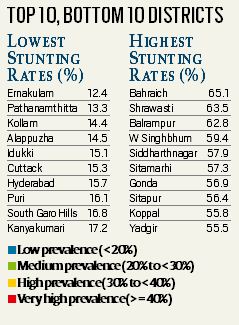Context:
- A study by the Washington-based agri think tank International Food Policy Research Institute (IFPRI) released has argued for a change in India’s approach to its malnutrition problem — by going beyond the current focus on health and stressing district-by-district reduction of socio-economic inequality and especially, gender inequality.
About the Study:
- The study has analysed and spatially mapped data from the National Family Health Survey 4 (NFHS 2015-16) on India’s high childhood stunting prevalence of 38.4%, and concluded that very high-stunting districts could eliminate 71% of the gap with low-stunting districts if they are able to improve on specific issues of gender and inequality.

- These include differences in women’s low body mass index (which accounts for 19% of the gap), women’s education (12%), children’s adequate diet (9%), assets (7%), open defecation (7%), age at marriage (7%), antenatal care (6%), and household size (5%). Stunting prevalence (percentage of under-5 children who have a low height for their age) is an important indicator of the nutritional status of children.
- A third of the global population of stunted preschoolers are in India. NHFS 4 data cited in the study show that the district-level variation in stunting lies in a wide range of 12.4% in Ernakulam (Kerala) to 65.1% in Bahraich (UP).
- More than two-thirds of India’s 640 districts, mainly in north and central India, have high to very high levels of stunting: 202 districts have a stunting prevalence of 30%-40%; in 239 districts, levels are above 40%.
Suggestion:
- Only focusing on health- and nutrition-related factors under the existing ICDS scheme isn’t enough; there is need to address gender-related inequalities at the district level so as to reduce stunting.
- Factors concerning women across their life cycles, such as their education, nutrition, age at marriage, care during and after pregnancy, play a significant role, as do the overall socio-economic status of the household.
Conclusion:
- The findings are significant coming just when the union government has launched its National Nutrition Mission (POSHAN Abhiyaan) with a district-level focus to reduce stunting.
Source:IE
